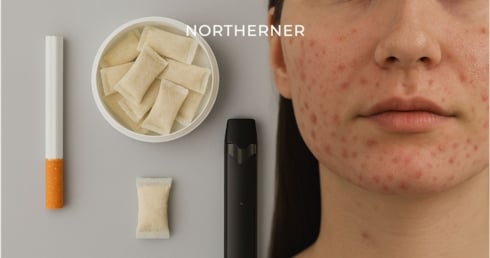Hi! Did you know that you can easily reorder a previous order on My Pages? Just click “reorder” to get all your favourites delivered again.
Published 2025-10-14
Does Nicotine Cause Acne?
Research hasn’t proven that nicotine directly causes acne, but some studies suggest it may influence oil production, inflammation, and circulation, all factors that can affect how skin looks and heals. Here’s what we know about nicotine and breakouts.

Key Points
- Research hasn’t confirmed a direct link between nicotine and acne.
- Nicotine may affect circulation, inflammation, and oil production.
- Cigarettes, vaping, and nicotine pouches each expose the body to nicotine differently.
Nicotine and Skin Health: The Basics
Many people wonder whether nicotine can affect their skin, particularly in relation to acne. As interest in nicotine pouches continues to grow, understanding how nicotine interacts with the body, and specifically the skin, has become more relevant.
How Nicotine May Affect the Skin
Acne is usually caused by a mix of factors, such as hormones, genetics, and environment. However, emerging research suggests nicotine may influence certain skin processes, including circulation, inflammation, and sebum (oil) production; all of which contribute to how the skin looks and heals. Nicotine can influence how the skin reacts to everyday stress or irritation, but the effect can differ from person to person.
What Research Has Found So Far
Most existing studies only assessed nicotine in the context of cigarette smoking1, and the results vary. However, nicotine is known to temporarily narrow blood vessels, which can reduce oxygen and nutrient delivery to the skin.
Some research on smokers suggests that nicotine might influence the type of acne people get. For example, a few studies found fewer blocked pores but more red, inflamed spots2. This suggests that nicotine’s effects on the skin can vary rather than follow one clear pattern.
Gaps in Current Evidence
Current evidence does not show that nicotine directly causes acne, but these factors highlight why some individuals might notice differences in their skin when using or reducing nicotine.
Most existing studies on nicotine and skin are based on smoking or vaping, and there is currently little direct evidence focused on oral nicotine pouch users. More research is needed, especially around novel, tobacco-free nicotine products like nicotine pouches, where evidence on potential skin effects remains limited.

How Acne Develops
Acne forms when pores become clogged with oil, dead skin cells, or bacteria.
Common triggers include:
- Hormonal changes: Shifts in androgen levels can increase sebum production.
- Genetics and stress: Both influence the skin’s inflammatory response.
- External irritants: Such as smoke, pollution, and harsh products can disrupt the skin barrier.
Research has shown that inflammation and sebum imbalance are central to acne formation3.
Nicotine Delivery and Skin Impact
Different nicotine products can affect the skin in distinct ways:
- Cigarettes: Smokers all also exposed to combustion byproducts that can dehydrate and stress the skin.
- Vapes: Ingredients such as propylene glycol may contribute to dryness.
- Nicotine pouches: Deliver nicotine without smoke or vapour. They contain no tobacco leaf and don’t expose the skin to combustion byproducts. However, some users have reported noticing changes in oil balance or skin hydration.
To explore how nicotine products interact with the body more broadly, visit our guide on the effects of nicotine pouches.
Skin Changes When Reducing or Stopping Nicotine
Some people notice temporary breakouts when cutting down or quitting nicotine. These can result from stress, hormonal adjustment, or circulation changes.
Over time, improved oxygen flow and skin recovery may support more balanced texture, though outcomes differ between individuals.
Other Factors That Affect Acne
It’s worth remembering that acne is a complex skin condition. Diet, stress, hydration, and skincare habits can all have an impact.
Supporting healthy skin often means:
- Maintaining consistent cleansing and hydration.
- Managing stress and sleep.
- Choosing non-comedogenic skincare.
- Seeking medical advice if acne persists or worsens.
Takeaways
The connection between nicotine and acne remains an open question. While nicotine can affect circulation and inflammation, it’s just one piece of a much larger puzzle involving genetics, hormones, and lifestyle. For now, the best approach is awareness; notice how your skin responds to changes, and consult a dermatologist if concerns persist.
Sources
- Acne and smoking, Bruno Capitanio et al.
- Association between smoking habits and acne. A case-control study and a systematic review and meta-analysis, Mannocci A, Semyonov L, Saulle R, Skroza N, Potenza C, Tolino E, et al.
- Relationships among smoking, oxidative stress, inflammation, macromolecular damage, and cancer, Andrew W. Caliri et al.
- Cardiovascular Toxicity of Nicotine: Implications for Electronic Cigarette Use, Neal L. Benowitz
